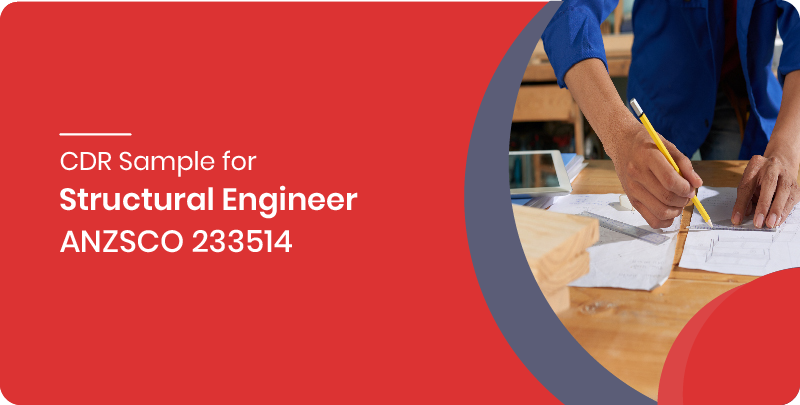Get Free Consultation
CDR Sample
Structural Engineering: ANZSCO 233214
Structural engineers are worried about planning and developing structures and structures that are sheltered and equipped for withstanding the components to which they will be uncovered, just as improving the basic respectability of existing structures. The activity is firmly identified with that of a structural designer.

Competency Demonstration Report (CDR) Sample for Structural Engineers
The Competency Demonstration Report Sample for Structural Engineer includes all the necessary reports such as Three Career Episodes, Continuing Professional Development, Summary Statement and Curriculum Vitae. The Content of the Sample is as follow
Structural Engineer Career Episode Report Samples
The career episode must be written on your own based on your recent work experience and must be in the English language. Each career episode should highlight the problems faced in your project and the steps taken to overcome them. It would be best if you numbered each paragraph of your career episodes as `` Career episode 1 (paragraphs 1.1, 1.2, 1.3, etc.) ``. The primary four components are as follows:
Project Name: Structural Behavior of Inflatable, Reinforced, Braided, Tubular Members
In first career episode, the author describes the project he did for the degree of Doctor of Philosophy. The project’s title was “Structural Behavior of Inflatable, Reinforced, Braided, Tubular Members”. The responsibilities of the author were to:
-
To improve understanding of structural behavior of HIAD components through material testing, structural testing of components, and numerical models
-
To quantify the stiffness of the reinforcing cords, which drive axial and bending stiffness of the inflatable tubes
-
To quantify the 3D shape of the tori and displacements using non-contact photogrammetry methods
-
To perform straight beam bending tests with highly controlled loading and boundary conditions on test articles constructed with a range of different braid angles to provide vital baseline data on the behavior of these composite structural members
-
To explore methods for structural testing full-scale tori via radial compression loading
Project Name: Weighing the Financial and Sustainable Benefits of High Performance Structures in Seismically Active Regions
In second Career Episode, the author prepared this thesis in partial fulfillment of the requirements for the Degree Master of Science in Architecture. His duties and responsibilities in the project “Weighing the Financial and Sustainable Benefits of High Performance Structures in Seismically Active Regions” were:
-
To investigate a structure utilizing Buckling Restrained Braced Frames (BRBF’s) as the Lateral Force Resisting System (LFRS)
-
To conduct the structural design and analysis
-
To develop a code level design using the American Society of Civil Engineers’ Minimum Design Loads for Buildings and Other Structures (ASCE 7-05)
-
To apply the financial structural costs in FEMA’s software Benefit Cost Analysis (BCA)
-
To develop carbon footprints for each structure
Project Name: Enhancing Ductility of One-Way Concrete Slabs Reinforced with Welded Wire Reinforcement
In third Career Episode, the author demonstrates his technical skills he used to complete the project he was involved in as an assignment project during his university study. The Project was “Enhancing Ductility of One-Way Concrete Slabs Reinforced with Welded Wire Reinforcement. The key responsibility of the writer was to:
-
To mitigate the strain localization effect and demonstrate the WWR can be used safely
-
To present a recommendation of details and minimum reinforcement required for WWR slabs
-
To examine the effects of strain rate on the mechanical properties of WWR and traditional rebar
-
To conduct a parametric study to examine the effect of steel ductility and geometry of the slabs on the behavior of WWR reinforced members
-
To give reinforced concrete designers rules such that they can be confident in their WWR designs
-
To demonstrate the strain rate effects on the mechanical properties of WWR and traditional rebar



